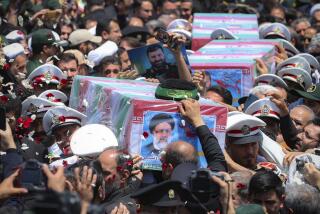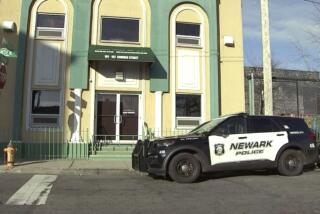Fighting Damages Shrine in Najaf
- Share via
BAGHDAD — Iraq’s holiest shrine suffered minor damage Tuesday after a night of heavy fighting in the city of Najaf, drawing condemnation around the country and leaving U.S. forces and militiamen loyal to Shiite Muslim cleric Muqtada Sadr blaming one another for the attack.
U.S. military officials denied firing the two projectiles that hit in and near the gold-domed Imam Ali shrine, damaging an inner gate and scattering debris around the compound.
Another projectile, possibly a mortar round, landed several yards away near Sadr’s office. At least four Sadr militiamen were injured, witnesses said.
Scores of Najaf residents protested around the shrine, raising their fists and pounding their heads with their hands, a ritual expression of anguish. The mosque is among the most sacred sites in Shiite Islam.
“The coalition forces had no involvement in the damage to the Imam Ali mosque,” said Army Brig. Gen. Mark Kimmitt, the top military spokesman in Iraq.
He said the attack appeared to have been caused by fighting between two factions in the city or by Sadr loyalists attempting to provoke outrage against the United States.
“We decry the attempts by Muqtada’s militia, and Muqtada possibly himself, to violate the sacred holy shrines of the Shia religion for his own personal gain, for his own personal advancement,” Kimmitt said.
About 2,000 U.S. troops have massed around Najaf to crush Sadr and his militia, but military officials insist they are steering clear of the city’s holy sites.
A Sadr spokesman scoffed at the notion that the militia would attack the shrine, which it already controls and where many of Sadr’s followers work.
“The shells that hit Imam Ali are the fault of the Americans,” spokesman Qaiss Qazali said.
It is the second time this month that the shrine has been damaged in fighting.
The new U.S.-appointed governor in Najaf said U.S. forces were necessary to restore peace and order to the city and warned that damage was unavoidable.
“In war there is no such thing as drawing a red line,” said Adnan Zurfi, who was appointed this month.
Grand Ayatollah Ali Sistani, Iraq’s leading Shiite cleric, issued no statement about the attack. Previously, Sistani has called upon the U.S. and Sadr’s militia to leave the city.
Shiites elsewhere in Iraq expressed outrage and frustration over the damage to the shrine. Many blamed Americans for entering Najaf and confronting Sadr, who is wanted in connection with the killing last year of a rival cleric.
“There is nothing holy to the Americans,” said Qassim Mohammed Kadim, a Baghdad shopkeeper who declared that damage to the shrine in Najaf is as upsetting to Shiites as Sept. 11 was to Americans.
Although they do not consider themselves followers of Sadr, Kadim and several friends drove to Najaf to see the mosque and hear Sistani’s reaction.
“If Sistani asks us, we will fight,” he said.
The damage to the shrine Tuesday morning followed a night of fierce fighting around Najaf. Sadr’s militia fired about 45 mortar rounds at U.S. forces in the area and hit a police station controlled by the Americans. The governor’s office was attacked with small arms and rocket-propelled grenades. Associated Press reported that 13 Iraqis were killed. By Tuesday evening, the city was quiet.
*
Special correspondent Saad Fakr Deen in Najaf contributed to this report.
--- UNPUBLISHED NOTE ---
In other stories this year, Sadr spokesman Qaiss Qazali is correctly referred to as Qais Khazali.
--- END NOTE ---
More to Read
Sign up for Essential California
The most important California stories and recommendations in your inbox every morning.
You may occasionally receive promotional content from the Los Angeles Times.










